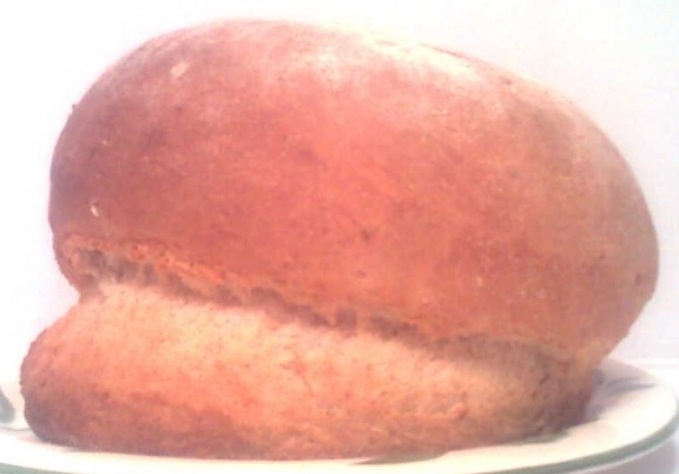My friend just sent me these pictures of her last bread. It looks funny and I hope it tastes well but I still wonder why it took that funny shape. Is underproofed or poorly shaped ?
Unfortunately, my friend doesn't have scales. She could only tell the recipe is about 40% medium rye, 40% white flour, 20% whole wheat. A kind of dough she makes usually but bakes in the bread machine.
So here the dough was made in the machine, proofed in sieve with floured cloth and than turned on a preheated teflon sheet (perforated pizza sheet).
Thanks for help
zdenka


best guess is underproofed.
also was the loaf scored on top? can't tell from the photos.
Hi Zdenka,
I would say that this is a combination of failures involving, scoring, proofing and shaping. Under proofing would be the biggest factor.
Jeff
If the loaf wasn't fully protected during final proofing and the surface dried out then, if it went into a hot oven with low humidity, the surface would harden and the expanding bread would have to take the hardened top layer with it as it expands so it would stretch the weakest point - usually one side or the other - to achieve it's goal to expand.
Thanks for your suggestions.
Do you think that the surface might have dried out too much when it was upside down in the sieve lined with floured cloth? How then could it be avoided? I'd think it's similar to proofing in a banneton and it never happened to me.
As for steem, the was a dish with hot water underneath the perforated sheet.
zd.
Once again, this is speculative, but for whatever merit it might have I'm happy to offer it.
Proofing in a sieve exposes the entire loaf, even when covered with a floured towel, to some amount of air on virtually all sides. A floured cloth will dry the surface of the dough, as will ambient air temperature/movement. Your friend has both of those villains to fight in that regard. It's why I often prefer to use plastic wrap in place of cloth. I assume your friend didn't oil the surface of the dough or provide any other means of preserving the moisture in the dough's surface. Proofing in an oiled bowl where the dough is tossed to ensure it's covered entirely with a thin layer of oil during the proofing can be very helpful indeed.
I have found, however, that a rice flour permeated cloth is less hygroscopic and seems to lift less moisture from the dough so that may be an option. Another option would be to proof the loaf in a Banneton or proofing basket that has a tighter weave than a sieve (wire strainer) and/or to mist the loaf immediately prior to placing it into the oven.
Scoring the loaf, eventhough it isn't a tradition for the breads baked in your region, would provide some help insofar as giving the expanding loaf somewhere to focus its energy and, in this case, it might have helped.
Scoring shouldn't be an issue as traditionally breads are never scored here (in the Czech republic).
My friend told me that the imprint after the poke test remained without springing back. But, I must admit she doesn't have much experience with oven bread baking.
It also seems that the sheet had not been preheated (she just intended to do so and later fotgot)
zdenka